Optically Active Telecom Defects in MoTe2 Fewlayers at Room Temperature
Abstract
1. Introduction
2. Materials and Methods
2.1. Sample Fabrication
2.2. Optical Measurements
3. Results and Discussion
3.1. Generation of Deep Defect States
3.2. Characterizations of Defects
4. Conclusions
Author Contributions
Funding
Institutional Review Board Statement
Informed Consent Statement
Data Availability Statement
Conflicts of Interest
Appendix A

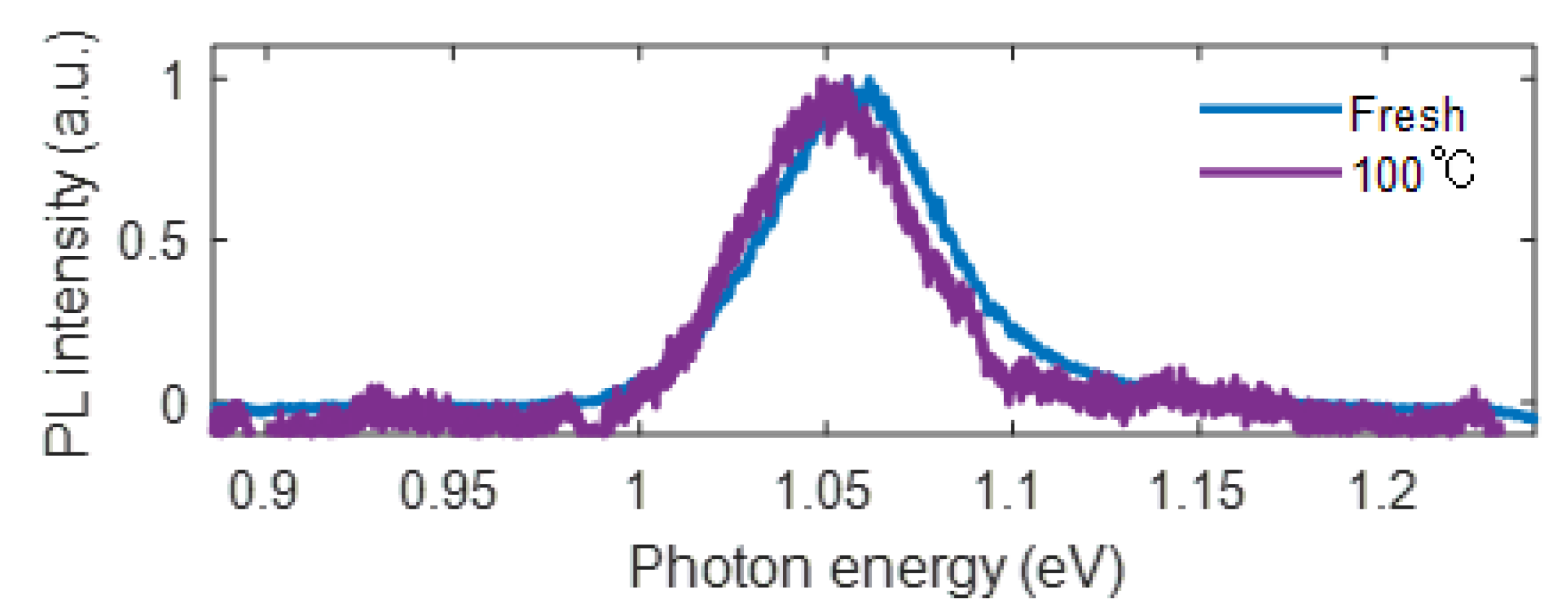
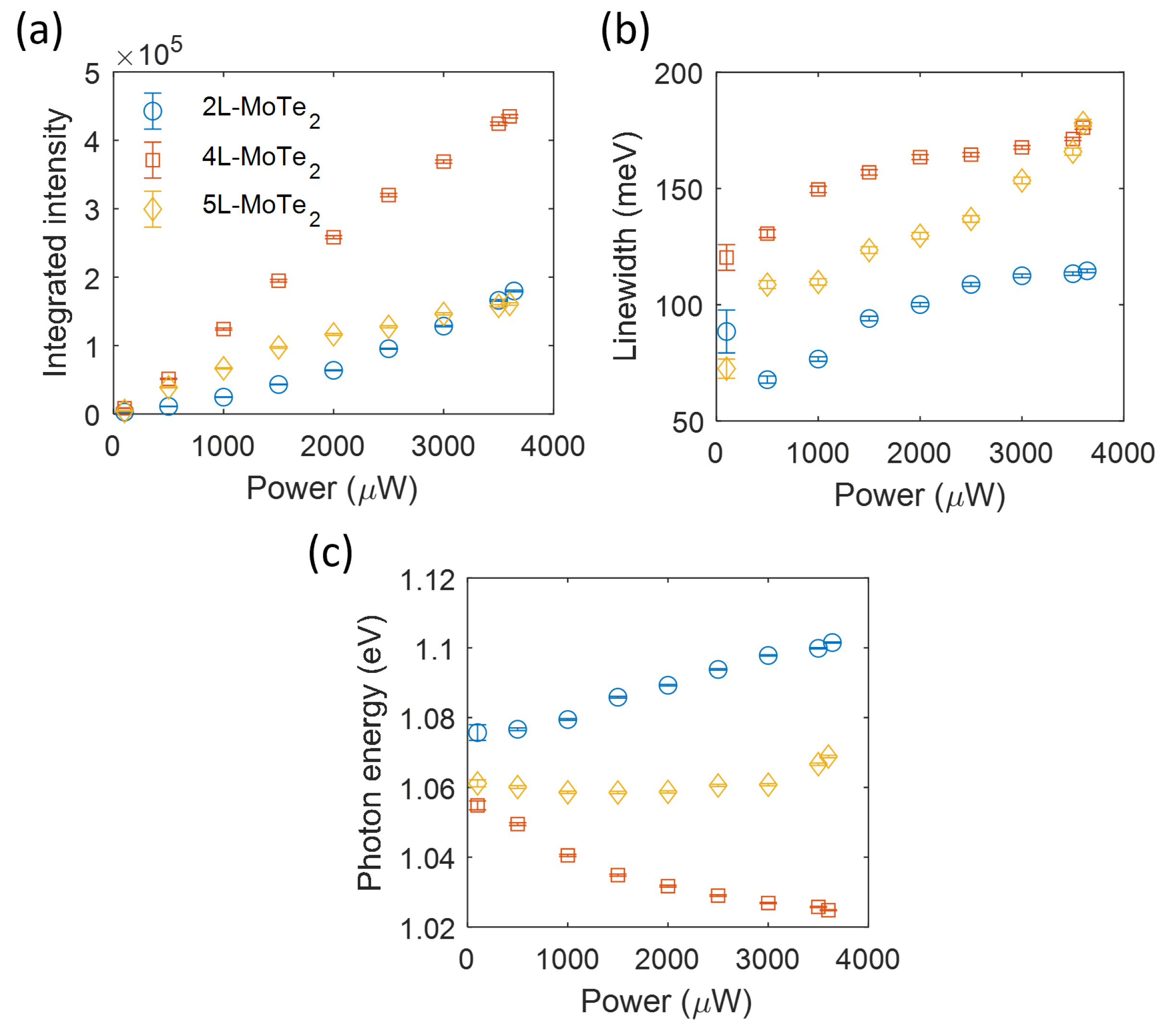
References
- Xu, X.; Yao, W.; Xiao, D.; Heinz, T. Spin and pseudospins in layered transition metal dichalcogenides. Nat. Phys. 2014, 10, 343–350. [Google Scholar] [CrossRef]
- Ramasubramaniam, A. Large excitonic effects in monolayers of molybdenum and tungsten dichalcogenides. Phys. Rev. B 2012, 86, 115409. [Google Scholar] [CrossRef]
- Chernikov, A.; Berkelbach, T.C.; Hill, H.M.; Rigosi, A.; Li, Y.; Aslan, B.; Reichman, D.R.; Hybertsen, M.S.; Heinz, T.F. Exciton binding energy and nonhydrogenic rydberg series in monolayer WS2. Phys. Rev. Lett. 2014, 113, 076802. [Google Scholar] [CrossRef] [PubMed]
- Mak, K.F.; Lee, C.; Hone, J.; Shan, J.; Heinz, T.F. Atomically thin MoS2: A new direct-gap semiconductor. Phys. Rev. Lett. 2010, 105, 136805. [Google Scholar] [CrossRef] [PubMed]
- Splendiani, A.; Sun, L.; Zhang, Y.; Li, T.; Kim, J.; Chim, C.-Y.; Galli, G.; Wang, F. Emerging photoluminescence in monolayer MoS2. Nano Lett. 2010, 10, 1271–1275. [Google Scholar] [CrossRef] [PubMed]
- Geim, A.K.; Grigorieva, I.V. Van der Waals heterostructures. Nature 2013, 499, 419–425. [Google Scholar] [CrossRef] [PubMed]
- Tran, K.; Moody, G.; Wu, F.; Lu, X.; Choi, J.; Kim, K.; Rai, A.; Sanchez, D.A.; Quan, J.; Singh, A.; et al. Evidence for moiré excitons in van der Waals heterostructures. Nature 2019, 567, 71–75. [Google Scholar] [CrossRef]
- Lin, Q.; Fang, H.; Liu, Y.; Zhang, Y.; Fischer, M.; Li, J.; Hagel, J.; Brem, S.; Malic, E.; Stenger, N.; et al. A room-temperature moiré interlayer exciton laser. arXiv 2023, arXiv:2302.01266. [Google Scholar]
- Srivastava, A.; Sidler, M.; Allain, A.V.; Lembke, D.S.; Kis, A.; Imamoğlu, A. Optically active quantum dots in monolayer WSe2. Nat. Nanotechnol. 2015, 10, 491–496. [Google Scholar] [CrossRef]
- Koperski, M.; Nogajewski, K.; Arora, A.; Cherkez, V.; Mallet, P.; Veuillen, J.-Y.; Marcus, J.; Kossacki, P.; Potemski, M. Single photon emitters in exfoliated WSe2 structures. Nat. Nanotechnol. 2015, 10, 503–506. [Google Scholar] [CrossRef]
- He, Y.-M.; Clark, G.; Schaibley, J.R.; He, Y.; Chen, M.-C.; Wei, Y.-J.; Ding, X.; Zhang, Q.; Yao, W.; Xu, X.; et al. Single quantum emitters in monolayer semiconductors. Nat. Nanotechnol. 2015, 10, 497–502. [Google Scholar] [CrossRef] [PubMed]
- Chakraborty, C.; Kinnischtzke, L.; Goodfellow, K.M.; Beams, R.; Vamivakas, A.N. Voltage-controlled quantum light from an atomically thin semiconductor. Nat. Nanotechnol. 2015, 10, 507–511. [Google Scholar] [CrossRef] [PubMed]
- Luo, Y.; Liu, N.; Li, X.; Hone, J.C.; Strauf, S. Single photon emission in WSe2 up 160 k by quantum yield control. 2D Mater. 2019, 6, 035017. [Google Scholar] [CrossRef]
- Parto, K.; Azzam, S.I.; Banerjee, K.; Moody, G. Defect and strain engineering of monolayer WSe2 enables site-controlled single-photon emission up to 150 K. Nat. Commun. 2021, 12, 3585. [Google Scholar] [CrossRef] [PubMed]
- Aharonovich, I.; Englund, D.; Toth, M. Solid-state single-photon emitters. Nat. Photonics 2016, 10, 631–641. [Google Scholar] [CrossRef]
- Ruppert, C.; Aslan, B.; Heinz, T.F. Optical properties and band gap of single-and few-layer MoTe2 crystals. Nano Lett. 2014, 14, 6231–6236. [Google Scholar] [CrossRef]
- Bie, Y.-Q.; Grosso, G.; Heuck, M.; Furchi, M.M.; Cao, Y.; Zheng, J.; Bunandar, D.; Navarro-Moratalla, E.; Zhou, L.; Efetov, D.K.; et al. A MoTe2-based light-emitting diode and photodetector for silicon photonic integrated circuits. Nat. Nanotechnol. 2017, 12, 1124–1129. [Google Scholar] [CrossRef]
- Li, Y.; Zhang, J.; Huang, D.; Sun, H.; Fan, F.; Feng, J.; Wang, Z.; Ning, C.-Z. Room-temperature continuous-wave lasing from monolayer molybdenum ditelluride integrated with a silicon nanobeam cavity. Nat. Nanotechnol. 2017, 12, 987–992. [Google Scholar] [CrossRef]
- Fang, H.; Liu, J.; Li, H.; Zhou, L.; Liu, L.; Li, J.; Wang, X.; Krauss, T.F.; Wang, Y. 1305 nm few-layer MoTe2-on-silicon laser-like emission. Laser Photonics Rev. 2018, 12, 1800015. [Google Scholar] [CrossRef]
- Duerloo, K.-A.N.; Li, Y.; Reed, E.J. Structural phase transitions in two-dimensional mo-and w-dichalcogenide monolayers. Nat. Commun. 2014, 5, 4214. [Google Scholar] [CrossRef]
- Guo, J.; Liu, K. Recent progress in two-dimensional mote2 hetero-phase homojunctions. Nanomaterials 2021, 12, 110. [Google Scholar] [CrossRef] [PubMed]
- Ghimire, M.K.; Ji, H.; Gul, H.Z.; Yi, H.; Jiang, J.; Lim, S.C. Defect-affected photocurrent in mote2 fets. ACS Appl. Mater. Interfaces 2019, 11, 10068–10073. [Google Scholar] [CrossRef] [PubMed]
- Zhao, H.; Pettes, M.T.; Zheng, Y.; Htoon, H. Site-controlled telecom-wavelength single-photon emitters in atomically-thin MoTe2. Nat. Commun. 2021, 12, 6753. [Google Scholar] [CrossRef] [PubMed]
- Castellanos-Gomez, A.; Buscema, M.; Molenaar, R.; Singh, V.; Janssen, L.; Van Der Zant, H.S.J.; Steele, G.A. Deterministic transfer of two-dimensional materials by all-dry viscoelastic stamping. 2D Mater. 2014, 1, 011002. [Google Scholar] [CrossRef]
- Fang, H.; Liu, J.; Lin, Q.; Su, R.; Wei, Y.; Krauss, T.F.; Li, J.; Wang, Y.; Wang, X. Laser-like emission from a sandwiched MoTe2 heterostructure on a silicon single-mode resonator. Adv. Opt. Mater. 2019, 7, 1900538. [Google Scholar] [CrossRef]
- Sie, E.J.; Steinhoff, A.; Gies, C.; Lui, C.H.; Ma, Q.; Rosner, M.; Schonhoff, G.; Jahnke, F.; Wehling, T.O.; Lee, Y.-H.; et al. Observation of exciton redshift–blueshift crossover in monolayer WS2. Nano Lett. 2017, 17, 4210–4216. [Google Scholar] [CrossRef]
- Liu, K.; Wu, J. Mechanical properties of two-dimensional materials and heterostructures. J. Mater. Res. 2016, 31, 832–844. [Google Scholar] [CrossRef]
- Lezama, I.G.; Arora, A.; Ubaldini, A.; Barreteau, C.; Giannini, E.; Potemski, M.; Morpurgo, A.F. Indirect-to-direct band gap crossover in few-layer mote2. Nano Lett. 2015, 15, 2336–2342. [Google Scholar] [CrossRef]
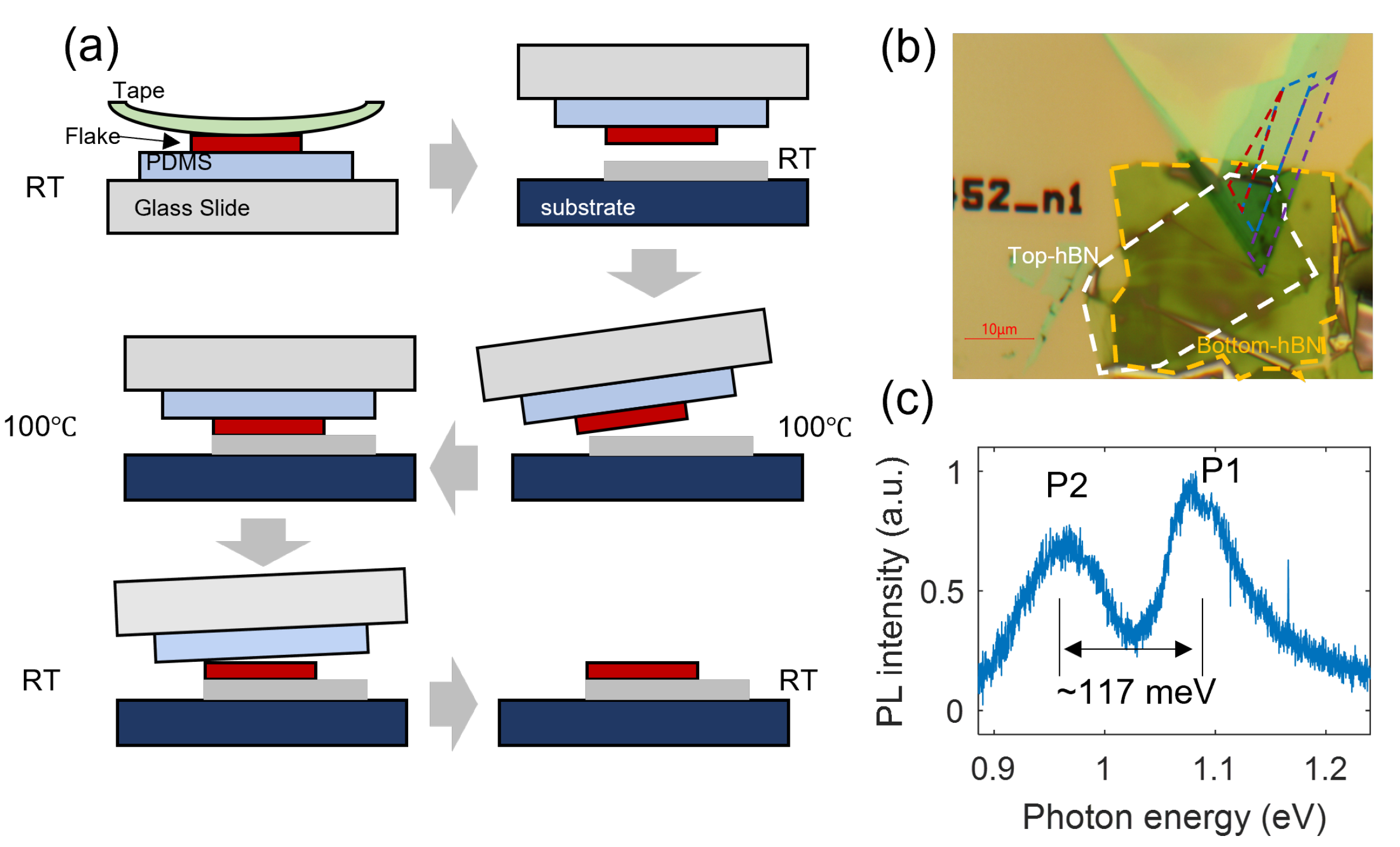

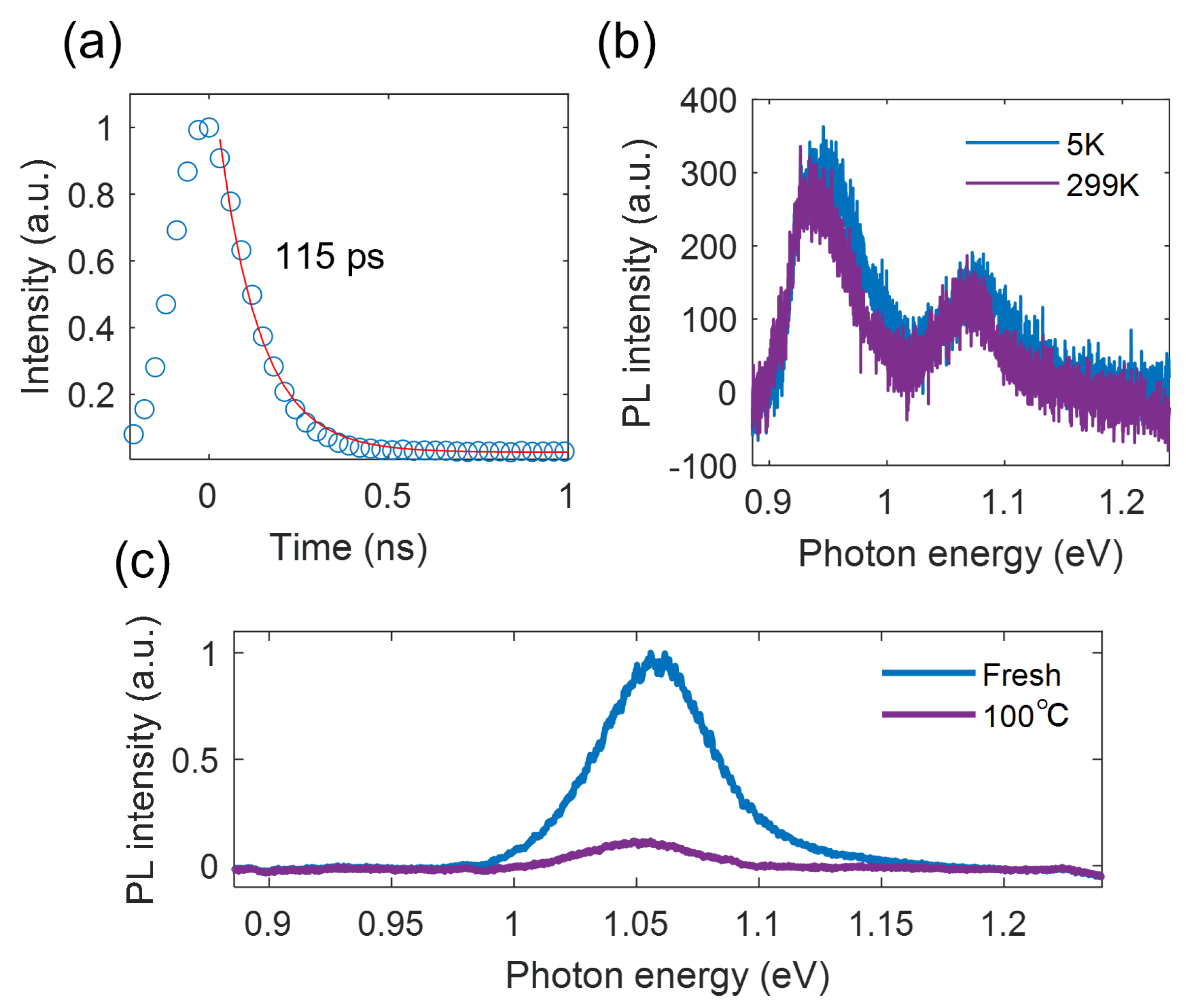
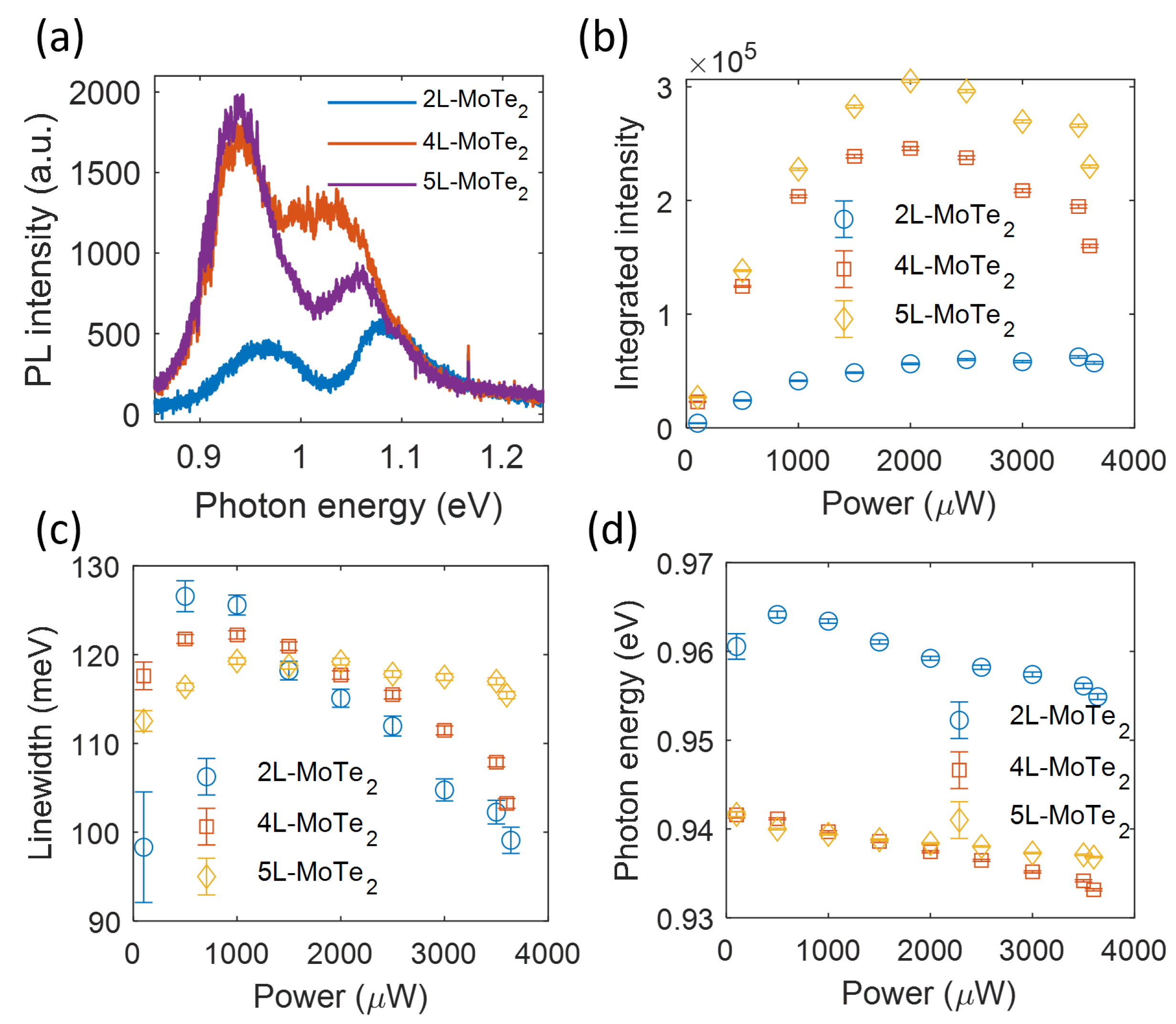
Disclaimer/Publisher’s Note: The statements, opinions and data contained in all publications are solely those of the individual author(s) and contributor(s) and not of MDPI and/or the editor(s). MDPI and/or the editor(s) disclaim responsibility for any injury to people or property resulting from any ideas, methods, instructions or products referred to in the content. |
© 2023 by the authors. Licensee MDPI, Basel, Switzerland. This article is an open access article distributed under the terms and conditions of the Creative Commons Attribution (CC BY) license (https://creativecommons.org/licenses/by/4.0/).
Share and Cite
Lei, Y.; Lin, Q.; Xiao, S.; Li, J.; Fang, H. Optically Active Telecom Defects in MoTe2 Fewlayers at Room Temperature. Nanomaterials 2023, 13, 1501. https://doi.org/10.3390/nano13091501
Lei Y, Lin Q, Xiao S, Li J, Fang H. Optically Active Telecom Defects in MoTe2 Fewlayers at Room Temperature. Nanomaterials. 2023; 13(9):1501. https://doi.org/10.3390/nano13091501
Chicago/Turabian StyleLei, Yuxin, Qiaoling Lin, Sanshui Xiao, Juntao Li, and Hanlin Fang. 2023. "Optically Active Telecom Defects in MoTe2 Fewlayers at Room Temperature" Nanomaterials 13, no. 9: 1501. https://doi.org/10.3390/nano13091501
APA StyleLei, Y., Lin, Q., Xiao, S., Li, J., & Fang, H. (2023). Optically Active Telecom Defects in MoTe2 Fewlayers at Room Temperature. Nanomaterials, 13(9), 1501. https://doi.org/10.3390/nano13091501





